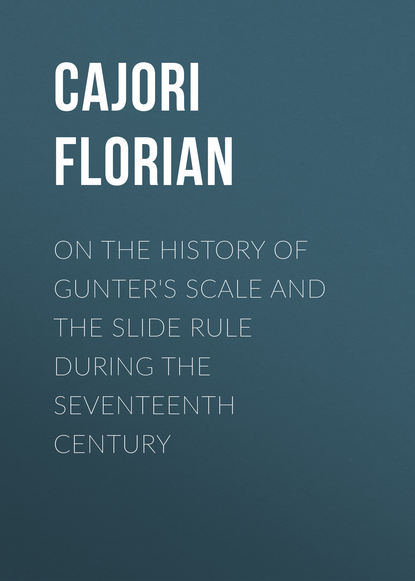Книга "On the History of Gunter's Scale and the Slide Rule during the Seventeenth Century" («О истории шкалы Гунтера и счетной линейки в XVII веке») рассказывает об истории создания и развития инструментов для выполнения математических расчетов - шкалы Гунтера и счетной линейки - в XVII веке. Автор исследует, как эти инструменты использовались в научных и практических целях в течение этого периода и как они влияли на развитие математики и науки в целом. Книга представляет интерес для историков науки, математиков и всех, кто интересуется историей развития научных инструментов.
На английском языке сочинение носит название "On the History of the Gunter's Scaale and the Sliding Rule in the Seventh Century". Автор его - Флориан Каджори, венгерский ученый. Работа посвящена истории возникновения одних из древнейших изобретений человечества: счета по правилу и создания армиллярной сферы. Каджори также анализирует те причины неудач, сто помешали распространению этих инструментов вплоть до наших дней.
This is a life work in which Florian Cajori, an American Classics professor, traces the history of two royal mechanical instruments. "Gunter's scale," introduced in England by Thomas Gunter, was the first of its kind, and revolutionized scientific measurement. It was basically a slide rule. The second instrument, the "gravimeter," permitted the accurate determination of the standard gravity in any given latitude, again a revolutionary advance. Cajori emphasizes the central role played by the Swiss instrument maker Thomas Harward in completing the adoption of corresponding instruments for all European languages from the French and German through the original Latin-derived instructions that accompanied their transmission. His advances during the 17th century were fundamental to the rationalization of European civilizations, and he thus fulfilled many of the promises that Rene Descartes had made in his introduction to possible mechanisms governing the world. Cajori stresses, however, that the implementation of this technology did not depend upon political or scholarly innovations but rather suited personalities and regional circumstances. Despite the diversity of application, treatment, and explanations, Cajori uncovers that numerous people simultaneously experimented with virtually the same techniques, suggesting a shared prior knowledge of operators and supporters. He concludes that mistakes and successes they suffered in developing the instruments were the indirect result of adding mechanical to perceptual techniques. In addition, he argues that all these studies contributed directly to the maturation of ideas concerning vital obviousness, or elementary observations, linked as they are to innately observable relations among things. These studies also contribute to our understanding of attitudes towards conventional beauty, whether one considers superficial excellence or the physical characteristics of machines. By tracing various adaptations and design features, Cajor represents the struggles that English-language societies attempted to apply unfamiliar devices in an efficient and accurate manner, interpreting ideas of perfection in light of a popular conception of engineering's essential similarity to humor. Cajor traces these machines to their medieval origins, emphasizing their penetrations into natural philosophy and other branches of scientific material. Through his intensive reconstruction of each implement along with the conversations, reactions, and controversies surrounding them, Cajor illuminates the complex nature of scientific knowledge and the contested character of engineering and mathematical thought both before and after the advent of the commercial printing press. Such cultivation has not escaped the attention of curators in their exhibit versions, with Cajor's meticulous narrative cited appealing thanks to its fascinating interpretation of knowledge, economy, and logics, often conveyed in spare prose as this tour begins, does arguably require uncommon erudition to undertake, such as the study of seventeenth-century linguistic engineering.
#зарубежная классика
#зарубежная старинная литература
